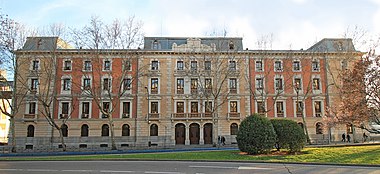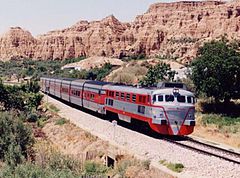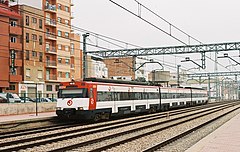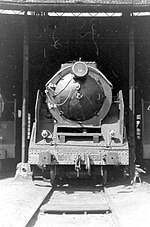National Network of Spanish Railways
The Red Nacional de los Ferrocarriles Españoles (RENFE), frequently advertised under its trademark Renfe, was a Spanish state-owned company that operated the national Iberian gauge railway network between 1941 and 2005. For more than six decades and as a monopoly, it was exclusively in charge of the transport of passengers and goods on its lines, as well as the management of its infrastructure.
It was founded in Spain at the beginning of 1941, after the end of the Spanish Civil War, and existed for almost 64 years until its dissolution on December 31, 2004. In compliance with European regulations on rail transport, RENFE was divided into into two new entities: Adif, the largest managing entity of the Spanish railway infrastructures, and Renfe-Operadora, the company that was left with the operation of the publicly owned railways. Later, starting in 2013, the same would happen with FEVE, the state-owned company in charge of the metric-gauge rail network.
History
Background
RENFE was founded in the context of the aftermath of the Spanish Civil War, with a good part of the Spanish railway network badly damaged during the war. However, the issue of the nationalization of the railways had already come a long way, since Francisco Cambó during his ministerial stage had already advocated this idea due to the deficient performance of the private railway companies, which maintained an outdated mobile fleet and to sometimes even a railway line in poor condition. With the outbreak of the civil war, on July 18, 1936, the railway companies were seized by the state in the State Decree of August 3, 1936. Although in the "rebellious" or "nationalist" area, the railways continued their independent existence, real control was exercised by the military and not by the Boards of Administration. After the war, thousands of kilometers of power lines were unusable, to which was added that 40% of the mobile fleet was destroyed and the remaining to be repaired. Faced with this situation, the new Francoist state in 1939 will manage the railway companies that are unable to carry out their work, prior to the creation of RENFE in 1941.
1941-1959
On January 24, 1941, the Government approved the Railway and Road Transport Regulation Bases Law by which all the Iberian gauge companies operating in Spain were brought together in a only state company, the National Network of Spanish Railways, RENFE. Of the most important nationalized companies, the Northern Spain Iron Roads Company (1858-1941), the Madrid to Zaragoza and Alicante Railway Company (1856-1941) and the Western National Railway Company (1928) stood out. -1941). The Andalusian Railway Company, due to its dismal economic results, had already come under State control in 1936, through its integration into that of the Western Railways. The next step taken by the state was the difficult task of calculating the amount of compensation that the old companies would receive. At the forefront in the priority of collecting the ransoms paid by the State (which would end up being quite high) were the bondholders, followed by the shareholders and, finally, in case there was anything left to distribute, the participating companies. Thus, RENFE became the dominant player in the Spanish railway for almost 64 years.
At the time of its creation, RENFE had 12,401 km of track as well as a varied and already outdated vehicle fleet from the old companies. In the first years of its existence, it had to respond to shortages of all kinds and the pressing need to rebuild the damage caused by the recent Civil War, a difficult task due to the scarcity of economic resources. The lack of spare parts and material wear was the cause of many serious accidents such as the one that took place in Torre del Bierzo in January 1944, the most serious in the history of Spain. In 1949 when the Plan General for Reconstruction and Urgent Reforms (known at the time as Plan Guadalhorce) with the aim of solving the most important needs. Among other things, it provided 5,000 million pesetas for the renewal of the Network and the development of an extensive program. The Plan also included the renewal of material: the acquisition of 200 locomotives, 5,000 wagons and 400 passenger cars was planned to complete initial orders from 1941.
In the 1950s, the fruits of the Guadalhorce Plan began to be seen and the pre-war situation was partly recovered, but Spain was an impoverished country and the improvements and beginnings of modernization were very timid. In spite of everything, some steps are taken that will be the timid symbol of the thought reforms. In the same year, 1950, the first commercial services of the Talgo began between Madrid and Hendaye, although it is not the only innovation; In 1952, the TAF diesel railcars came into service, representing a great qualitative leap in long-distance travel. And two years later, in 1954, the first Centralized Traffic Control center was inaugurated, located between Ponferrada and Brañuelas. Coinciding with the end of the decade, two events of great importance took place: in 1958 the Zamora-Orense railway came into service, whose construction had begun in 1927 and which had lasted until now. First "Swiss" for suburban traffic. However, this period of advances and planned investments by RENFE within the Stabilization Plan came to an abrupt halt in 1959, in response to inflation and the serious economic crisis that Spain experienced at the end of that decade.. The causes of this serious crisis are the clear failure of the autarchic policy that had prevailed in the Franco regime since 1939 and that had tied the Spanish economy.
1960-1989
Developmentalism in the 1960s meant a progressive improvement in the Spanish economy that also translated for the railways. In this sense, there was a significant improvement in RENFE's rolling stock, although it did not cover all lines or the entire fleet. The improvements always moved on the main lines that concentrated the greatest passenger traffic, such as the Madrid-Barcelona line, which is electrified and equipped with double track for most of the route.
In the case of the railway line, in 1962 the World Bank, within a comprehensive report on the Spanish economy, recommended abandoning investments in new lines and focusing the budgetary effort on improving the existing network. The only project that was saved from these cuts was the Railway from Madrid to Burgos via Aranda de Duero, which would be inaugurated a few years later. Following the lines recommended by the World Bank report, in 1964 the Government approved the Ten-Year Modernization Plan from 1964 to 1973 that would bring modernization of the mobile fleet and the improvement of the railway network allowed that in 1967 the maximum speed of some trains was raised at 140 km/h. The beginning of the 1970s brought a slowdown in the Ten-Year Modernization Plan from 1964 to 1973, which would ultimately give rise to the RENFE Plan 1972-1975, with an important modernization program.
On June 23, the last steam locomotive (a Mikado, specifically number 141F 2348) was put out of service at the Vicálvaro Classification Station (Madrid). The disappearance of steam traction will not be the only event that occurs this year, while on November 20 the dictator Francisco Franco dies and with it begins the beginning of the end for Francoism. This will affect RENFE as it will mark the beginning of a time of extensive reforms that seek to convert the Spanish railways into an efficient means of transport. The situation that RENFE had reached at the end of the seventies with gigantic annual deficits and a rail service that, in addition to being inefficient, had proven unsustainable. In 1979 the first Program Contract was signed, drawn up as the General Railway Plan and which was to have been in force for 12 years but which would only be carried out very partially. In addition, Cercanías services began to be implemented in Madrid, Barcelona, Málaga or Valencia, with the aim of absorbing the passenger traffic that moves in these large urban centers. The Cercanías will become one of the jewels in the crown for RENFE. However, any new reform plan that is made clashes with reality.
In 1984 RENFE found itself in a critical situation with gigantic annual deficits and that is, its trains move mainly in only 5,000 km of the 13,000 km of track it manages: There are too many lines that are not profitable. For this reason, the 1984 Program Contract was agreed upon, whereby on January 1, 1985, 914 km of tracks were closed and another 933 km were left for the exclusive use of merchandise: 12 lines and 132 stations were left without service. In addition, the autonomous communities come to the rescue of more than 600 km to avoid its closure. The modernization of facilities will be carried out, such as the stations of Madrid, Seville or Barcelona, which undergo profound transformations to adapt to new needs. Many other stations and tracks are also modernized. Specifically, the Atocha traffic was absorbed by the Chamartín Station until the inauguration of the new Atocha Station in 1992.
1991-2005
Continuing with the projects already launched in the eighties, in 1991 the works of the New Railway Access to Andalusia (NAFA) continued, which involved the construction of the Santa Justa Station to concentrate rail traffic in Seville. This in turn led to the dismantling of the San Bernardo and Plaza de Armas stations in Seville. A large part of these works carried out in the city of Seville had another reason: the celebration of the Universal Exposition of 1992 (Expo 92). In Barcelona there was a reorganization of the track fleet that circulated through different areas of the city, as well as the improvement and adaptation of some stations such as Barcelona-Termino (renamed France Station) and Barcelona- sants. And as in Seville, these works were carried out within the framework of an urban reorganization on the occasion, in this case, of the celebration of the 1992 Olympic Games in Barcelona. On April 14, 1992, the Madrid-Seville high-speed line was inaugurated, coinciding with the inauguration of Expo'92. It was a great moment for RENFE and the History of Spanish railways, which gave the world an image of modernity thanks to the publicity of Expo'92 and the Barcelona Olympics.
Another important measure was the creation of the Business Units in 1991, a consequence of the thorough reorganization of RENFE's rail services and whose creation would end up making the territorial model of the Zones disappear. This new model pursues economic profitability, reducing bureaucracy and the high costs involved in organizing in Zones. From now on, RENFE will be organized around the three main business units: Cercanías, Media Distancia and Larga Distancia.
On December 30, 1998, the company Gestor de Infraestructuras Ferroviarias (GIF) was founded, a public business entity that was created due to the rail transport measures that the European Union began to promote from Council Directive 91 /440/CEE on the Development of Community Railways, where it established (among other issues) the separation between the train operators and the infrastructure manager. In 2003 the Madrid-Lérida section of the Madrid-Zaragoza-Barcelona-French Border high-speed line (at 200 km/h) was inaugurated, being the second inaugurated in Spain after Madrid-Seville and the first in the 19th century. XXI.
Because of the new economic directives of the European Union, the State had to open the railway network to competition, for which reason new legislation was established for the railway sector (LSF, or Law 39/2003 of the Railway Sector), which in principle was to enter into force on June 1, 2004, but was delayed with the assumption of the Government of José Luis Rodríguez Zapatero on January 1, 2005. That day the public business entity « Renfe" separated from RENFE and from that moment on it began to be called "Administrador de Infraestructuras Ferroviarias" (Adif). The functions of the old company were divided between the two new entities:
- Renfe-Operadora, which is responsible for the transport of goods and passengers, in competition with other companies. It also carries out the maintenance and manufacture of railway material, participating in important national and international projects.
- Adifwhich manages roads, stations, communications, etc., charging a canon to the user companies of the network, including Renfe.
Internal structure
Starting in 1990, the internal structure of the company changed with the creation of Business Units, being restructured as follows:
- Near Business Unit
- Regional Business Unit
- Long Tour Business Unit - Large Lines
- High Speed Business Unit
- Cargo Business Unit
- Combined Transport Business Unit
- Merchandise Business Unit
- Integrated Train Maintenance Business Unit
- Infrastructure Maintenance Business Unit
Presidents
| Name | Home | Final | Notes |
| Gregorio Pérez Conesa | 21 January 1941 | 30 January 1944 | Nationalization of railways and creation of RENFE. |
| Eduardo Alfonso Quintanilla | 30 January 1944 | 11 February 1947 | |
| Rafael Benjumea and Burin | 11 February 1947 | 23 October 1952 | |
| Alfonso Peña Boeuf | 23 October 1952 | 3 July 1957 | |
| Agustín Plana Sancho | 3 July 1957 | 20 July 1962 | Abandonment of the Baeza-Utiel Line. |
| Carlos Mendoza Gimeno | 20 July 1962 | 22 July 1967 | |
| Leopoldo Calvo-Sotelo | 22 July 1967 | 26 July 1968 | Inauguration of the direct railway Madrid-Burgos. |
| Alfonso Osorio García | 26 July 1968 | 6 June 1970 | |
| Francisco Lozano Vicente | 6 June 1970 | 19 December 1975 | Death of Francisco Franco. |
| Plácido Álvarez Fidalgo | 19 December 1975 | 22 February 1978 | |
| Enrique de Guzmán Ozamiz | 22 February 1978 | 3 April 1978 | |
| Ignacio Bayón Mariné | 3 April 1978 | 18 June 1980 | |
| Alejandro Rebollo Alvarez-Amandi | 18 June 1980 | 4 September 1982 | |
| Antonio Carbonell Romero | 4 September 1982 | 4 January 1983 | |
| Ramón Baixados Male | 4 January 1983 | 12 September 1985 | 1984 programme contract: closing of deficit lines. |
| Julián García Valverde | 12 September 1985 | 16 March 1991 | |
| Mercè Sala Schnorkowski | 16 March 1991 | 18 June 1996 | Opening of the Madrid-Sevilla High Speed Line. |
| Miguel Corsini Freese | 18 June 1996 | 8 May 2004 | Opening of the Madrid-Lérida High Speed Line. |
| José Salgueiro Carmona | 8 May 2004 | 1 January 2005 | RENFE's disappearance. |
Territorial organization
Origins
In its first five years of operation, the primitive RENFE maintained a bureaucratic division of its network based largely on the territorial limits of the former absorbed companies, for which reason they used to speak of the "Northern zone", the "zone MZA», the Andalusian area, etc.
This system soon proved obsolete and on April 6, 1948 a new division by zones was implemented, creating a total of seven and receiving the same name where its center was located: Madrid-North, Madrid-Atocha, Seville, Valencia, Barcelona, Bilbao and Leon. In the case of Madrid, it was divided in two, so the railways that left Madrid to the north had their center at the Estación del Norte (current Príncipe Pío Station) while those that left to the south had their center at the Estación from Atocha. The cars and wagons had a label (usually located on the underside of the wagon) marked with the number of the zone to which they belonged. The Zone Directors came to have, especially in the decades of the forties and fifties, an almost military authority, often having small automobiles for their personal transport to inspect the routes under their charge.
Network Zones
This division of the 7 zones remained almost intact for many years, being in 1973 the limits of the zones marked by the following lines:
- First area (Madrid-Norte): With its central services in Madrid, Príncipe Pío station. It was extended by the lines that were born in Madrid to the North, with boundaries from West to East, in Palazuelo-Empalme, border of Portugal, Puebla de Sanabria, Astorga, Santander, Venta de Baños, Burgos and Coscurita. The Venta de Baños-Burgos section of the Madrid line to Irún had belonged in 1948 to the Sixth Zone.
- Second area (Madrid-MZA): Headquartered in Madrid, Atocha station, and boundary on the border with Portugal on the west side, Zafra, Almorchón, Santa Cruz de Mudela and Villarrobledo in the south, Utiel al Este, and Casetas and Soria on the northwest edge.
- Third area (Sevilla): It practically coincided with the Andalusian region, and its limits were Zafra, Almorchón, Santa Cruz de Mudela and Baza.
- Fourth area (Valencia): He understood the Levantine region and the province of Teruel. Its limits were, from South to North, the stations of Baza, Villarrobledo, Utiel, Calatayud, Zaragoza-Delicias and Tortosa.
- Fifth area (Barcelona): It understood Catalonia and Aragon and reached the French border, north; Zaragoza and Tortosa, west and south respectively. The head of Zona was Barcelona-Término.
- Sixth area (Bilbao): With southern limits in Casetas, Calatayud, Soria, Burgos and Venta de Baños. In Calatayud the only case of coexistence of three areas of Renfe in a single population was given for a long time, as the line from Madrid to Barcelona (ex-MZA) belonged to the 2.a, that of Calatayud to Cidad Dosante (ex-SM) to the 6.a and that of Calatayud to Valencia (ex-CA) to the 4.a. In the original division of 1948, the 2.a, 5th and 6th Zones coexisted in Casetas.
- Seventh area (Leon): He understood the Galician provinces, Asturias and León, based in the capital of this last province and limits in Palencia, Astorga and Puebla de Sanabria.
Following the completion of the works from the 1933 Rail Links Plan, a large number of new lines were incorporated into RENFE in the Madrid-capital area between 1967 and 1972, giving rise to numerous contact points between the First and the Second Zone. Madrid had ceased to be a terminal station for many passenger trains, to become a way station, which eventually led to the unification of the two zones into one, called the "Central Zone". The opening of the Chamartín Station in 1967, which led to the decline of the Estación del Norte, also influenced this, with its powers being transferred to the Atocha Station. To avoid a number remaining unassigned, the number 2 was awarded to the Asturian-Galician-Leon area previously represented by the number 7.
On January 1, 1987, RENFE brought into force Circular number 5372, by which the size of the Central Zone was reduced, to balance its size with that of the peripheral zones. In the 1990s, the "zones" gradually disappeared and were replaced by operational managements, reflecting the end of military terminology in favor of Anglo-Saxon-inspired corporate terminology. In 2005, the powers of the National Network at the infrastructure level were transferred to Adif, and those of rolling stock and operation to Renfe.
Motor material
Steam traction
Diesel traction
Electric traction
Contenido relacionado
Urban cycling
Yacht skipper
Beijing Capital International Airport






